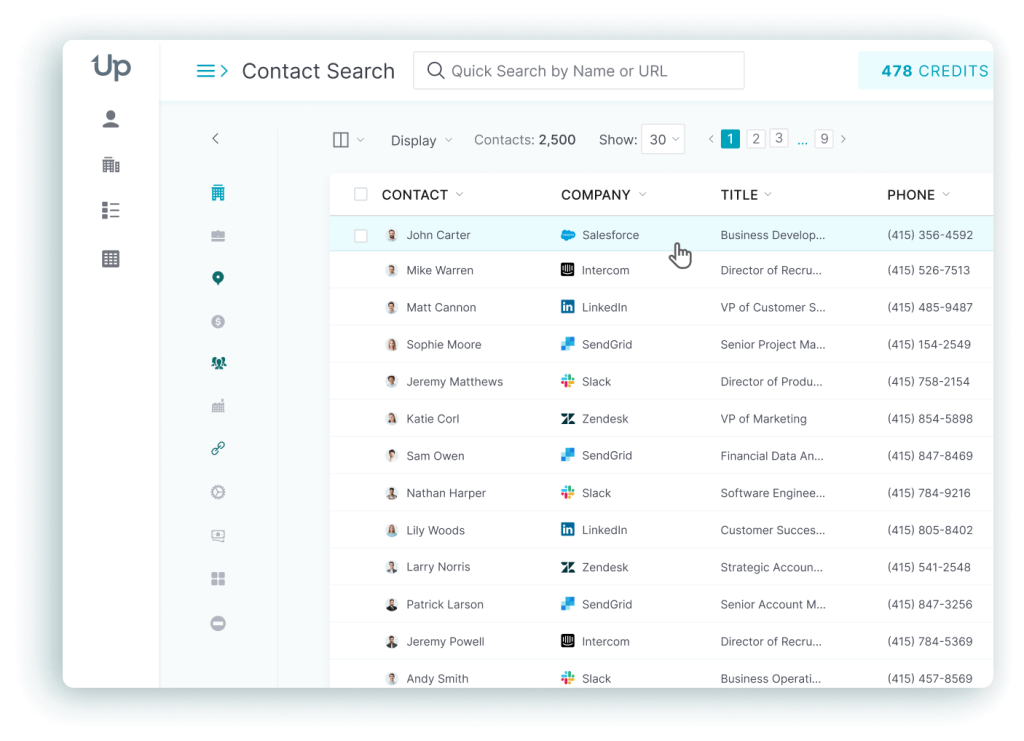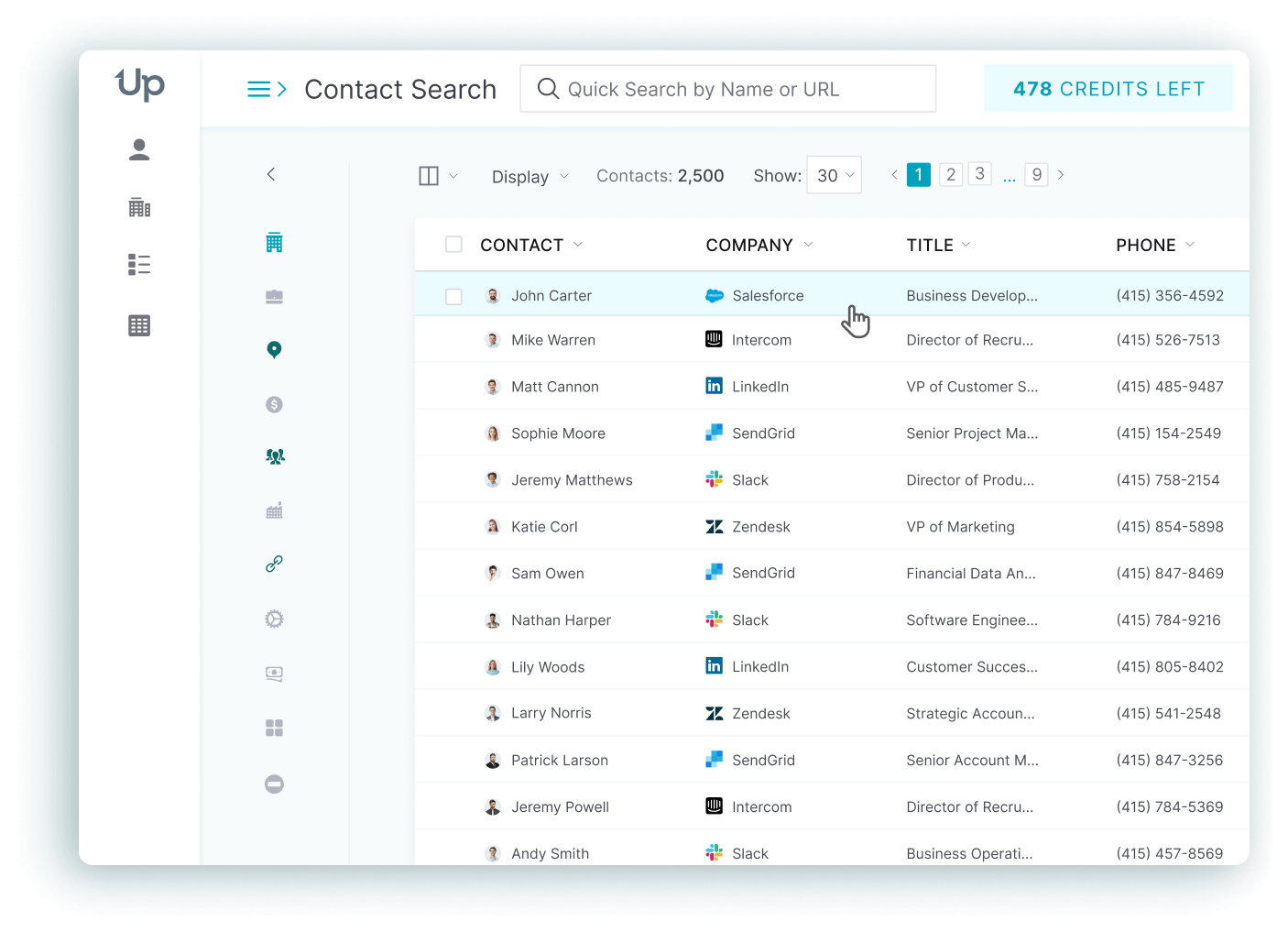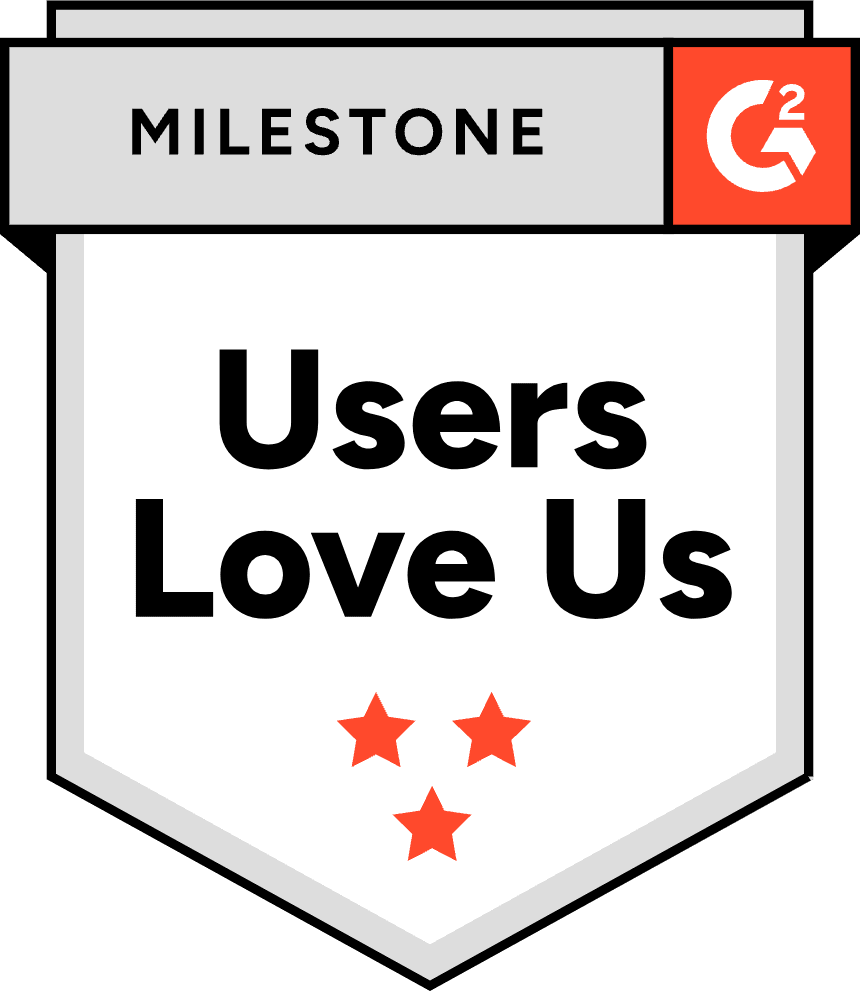\An essential part of making successful B2B sales and achieving business growth is reaching the right person. You could have the best pitch and product on the planet, but if you’re not reaching out to a decision maker, it could take weeks for your pitch to reach the right set of eyes (if it ever does).
To accelerate the sales process and ensure your pitch reaches the right person, identify these decision makers early and reach out to them directly.
This guide will help you learn about how to identify key decision makers, the different types of decision makers, how to reach them, best practices, and more.
What Are Business Decision Makers?
Business decision makers are the people who have the final say in major choices that affect the company. This may include purchasing decisions, deciding which organizations to partner with, choosing which marketing strategies to use, how the budget is spent, or evaluating which software to use.
They’re often high-level executives, leaders, managers, or department heads who are largely in charge of how a company or team operates.
Keep in mind that there are often multiple decision makers within an organization. In fact, according to research, companies with between 100 and 500 employees have an average of seven people who participate in buying decisions. As a result, there’s rarely just one person within a business that you’ll be able to reach out to if you’re looking to connect with a decision maker.
Chain of Command for Decision Makers in Business
Within many organizations, there’s a hierarchy of business executives and decision makers. While it varies from company to company, here’s a common chain of command for business decision makers, and what each group is often responsible for doing:
- Chief Executive Officer (CEO) – This is often the highest-ranking person within an organization. They’re responsible for guiding the direction of the business, daily operations, developing goals, setting the company vision, and more. They’re also generally the face of the company, and they supervise other senior executives.
- Senior executives/Other C-suite executives – This often includes the Chief Operating Officer (COO), Chief Financial Officer (CFO), Chief Information Officer (CIO), and others. In some cases, Vice Presidents (VPs) or Senior Vice Presidents (SVPs) are at this level. These people manage and oversee the major business areas within a company, help to implement plans, advise the CEO, and make recommendations within their purview.
- Middle management – This includes department heads and managers, who generally oversee a certain department and ensure it’s operating as it should. They’re often in charge of hiring and training within their department, and are a bridge between the higher levels and the lower levels.
- Supervisors – Supervisors are in direct contact with employees, and watch and evaluate them as they work. They may also be responsible for organizing workers, delegating tasks, resolving employee issues, and enforcing rules and policies. These workers often report to middle management.
- Employees – Other, non-managerial employees are those who carry out a majority of the work within a business, whether it be building products, analyzing data, making sales, communicating with customers, or performing any number of other tasks.
If you want a visual representation of how this hierarchy may work within many companies, this image from WalkMe is a good reference:
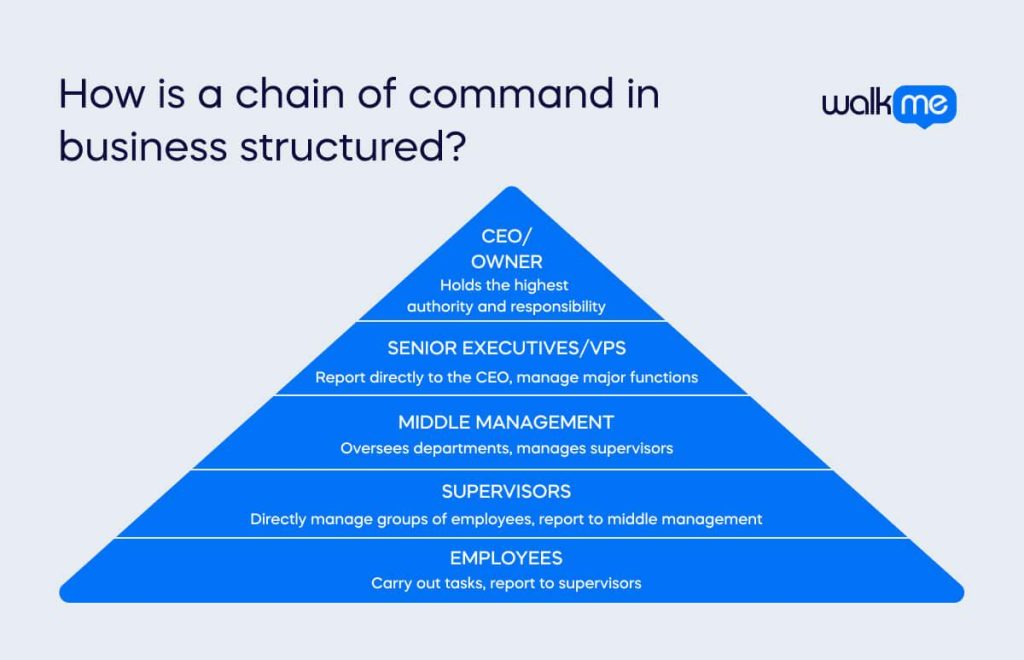
Source: https://www.walkme.com/blog/chain-of-command-in-business/
Keep in mind that every company is different, so this is only an example of how some businesses operate. Others may have more levels of managers, supervisors, or executives to differentiate roles or duties, while some may have fewer.
Some companies may also have a board of directors that typically sits above the CEO in this hierarchy, which also serves as the final decision maker. This is a group of people that shareholders elect to run the company, and the board typically appoints and advises a CEO, whom they put in charge of daily operations.
If the board is unhappy with the CEO’s performance, they can usually fire them and replace them with someone who is potentially better suited for the role.
5 Types of Business Decision Makers
While every company has some decision makers who are in charge of leading the company in the right direction, each decision maker is different. Let’s take a closer look at five types of business decision makers and the kinds of decisions they’re often charged with.
1. Brand Centric
The brand-centric decision maker is an individual who is primarily focused on promoting and improving the company’s brand. They make each decision with the brand image in mind, always considering how their decisions may impact the company’s public image. They often examine and consider a lot of information from many different people before ultimately making a decision.
2. Multifocal
Rather than focusing on one sole objective, a multifocal decision maker often considers a variety of goals, outcomes, and factors. While they may be focused on improving the brand image like the brand-centric decision maker, they’re also focused on other things, like increasing profits, reaching more customers, or ensuring all customers are satisfied.
These decision makers are often open to different approaches and strategies to reach these goals, such as unique business models, new pricing strategies, new technology, or additional revenue streams. They’re also generally comfortable testing new things via trial and error to see if they’re effective or not.
3. Aggregator
The aggregator is a decision maker whose main focus is on improving the finances of a business, often through gathering more leads and generating more sales. As a result, many of their strategies and ideas focus on new or innovative ways that companies can attract new customers, whether it’s a new product, a new feature, a new advertising strategy, or any number of other innovations.
These decision makers tend to place less of a focus on abstractions like brand image and are more concerned with the direct financial consequences of their decisions. They’re detail-oriented and organized, and aren’t afraid of taking risks as long as the analysts, marketing team(s), and other experts believe these risks will pay off.
4. Risk Taker
Risk takers make riskier decisions that, despite a relatively high chance of failure or even fallout, also offer a high reward if successful. They are very comfortable trying new things and embracing innovative and unique ideas, even if they’re unproven.
These people are generally much more willing to embrace uncertainty and roll with the punches. They often make decisions quickly and are focused on the “big picture” and long-term company goals, as opposed to short-term losses or gains.
5. Cautious
The cautious decision maker is the opposite of the risk taker, as they take a ton of time to consider all outcomes, consequences, and risks before making any decision. They prefer using methods and techniques that have been proven to work in the past, as opposed to new and untested ones.
They focus primarily on avoiding company losses and look to minimize risk at every opportunity. These decision makers evaluate all available options, make calculated and data-driven decisions, and are less comfortable exploring uncertainty.
How to Identify Business Decision Makers
Here are a few of the best ways to help you identify business decision makers, so you know who to reach out to, so you’re not wasting your time.
Perform Company Research
If the company has a website, you can use it to understand the structure of the organization and learn which people are in charge of which business areas. These sites often display exactly who the key personnel are within the company, so you’ll know exactly who to prioritize connecting with.
Here’s how you might identify business decision makers through a company’s public website:
- If you have a target company in mind, find its site through a web search. Otherwise, you can find multiple companies that match your target clientele with keywords, such as“marketing companies in X city” or “construction companies in the Y area.”
- Once you’ve gotten to the company website, navigate to the page that lists key members of the organization or, more specifically, its team(s). This may have a different name depending on the site you’re on, but it is often “About,” “Meet the Team,” “Our Team,” or something along those lines.
- Find the person most relevant to what you’re looking for, and reach out. This page may contain contact information, but if not, try another web search for the person’s profile elsewhere. Professional networking sites, like LinkedIn, should provide you with a way to communicate.
In addition to the company website itself, you can use B2B databases to access valuable contact data. Many of these contain millions of contacts in a variety of industries, so you can not only learn who holds leadership positions at different companies, but also how you can reach them.
These can provide everything from email addresses to CEO phone numbers, job titles, and potentially even links to their social media profiles. Thankfully, the process for finding decision makers on many of these platforms is also simple.
For example, here are the quick and easy steps to filter for decision makers on UpLead:
1. Log in to your UpLead account, and navigate to the Contacts menu on the sidebar.
2. Click Name or Title.
3. Type in any job title or keyword that you want, and the tool instantly provides you with the contacts that meet your criteria.
4. In addition to contact name or job title, you can also filter by job function, management level, or contact skills.
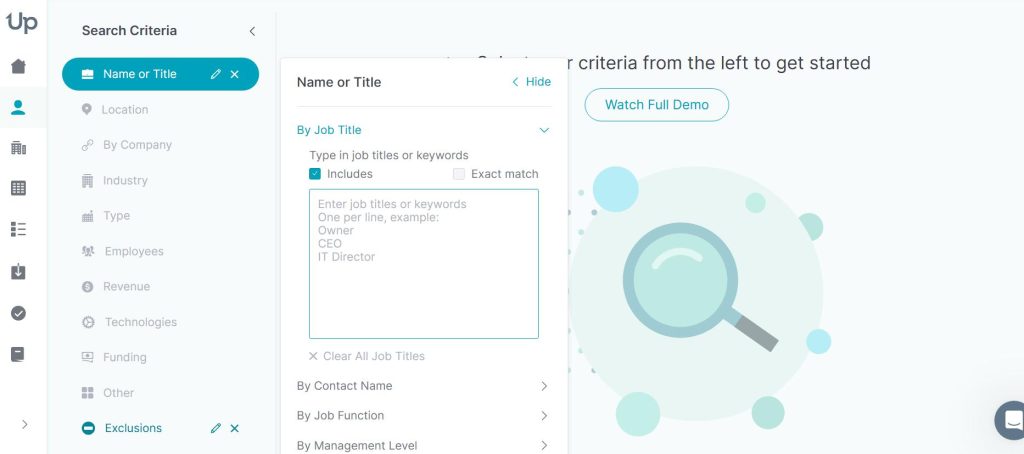
Use Social Media
While there are numerous platforms where these decision makers may be active, LinkedIn is often your best bet. It has several advanced search filters that you can use to look for individuals who are likely to be responsible for key decisions within their organization.
For example, you can search by titles like CEO, CFO, or VP of Sales. Doing this is easy and only takes a few steps.
- Log in to your LinkedIn account and navigate to the Search page.
- In the top navigation bar, make sure to select People.

- On the following page, click All filters in the top navigation bar.

- In the menu that pops up, scroll down to Title and add whatever position you’re searching for.
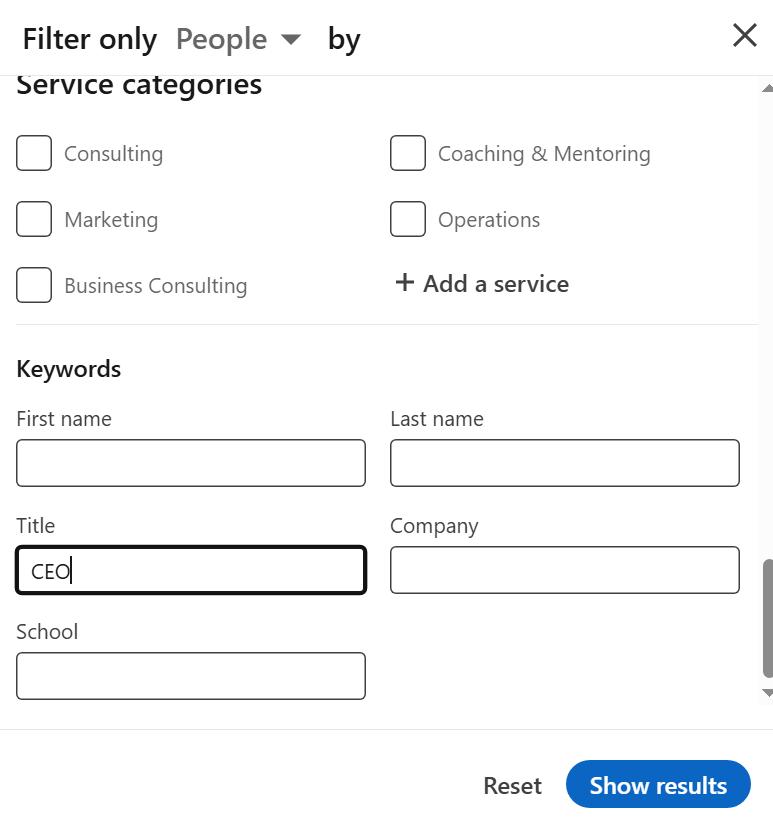
- After clicking Show results, you’ll be greeted by a list of results that match the job title you searched for.
You’re also able to search by industry, by a specific keyword, by different service categories, and even by past and current companies.
Reach Out to the Company
If your online searches and social media scouring aren’t paying off and you still don’t know who the decision makers are at your target company, you may want to reach out to the organization directly.
While you’re not likely to instantly reach a decision maker with your first message, you can ask them to direct you to the right place.
For example, you could send a message to a general customer support representative:
“Hello, I’m a sales associate for X company, and I’m wondering if you could put me in contact with the person or team that’s in charge of Y.”
Sometimes, simply reaching out to connect with a decision maker will not only get you the right contact info, but it will also pave the way for a long, constructive business relationship.
How to Reach Decision Makers for Maximum Impact
If you want the best results when reaching decision makers, here are some important things to keep in mind.
Use the Right Tools and Methods
Using the right company research tools helps you find the decision maker’s contact information that you need to reach out to them in the first place. While you can know everything about how to email a CEO, if you don’t know where to send the email, your outreach efforts will fail.
These tools can provide you with everything from a detailed IT decision-makers email list, a list of executive social media profiles, CEO emails, and direct phone numbers for decision makers.
As for how you should reach out to these decision makers for the best results, you have several options. In fact, most B2B decision makers are using more channels than ever to communicate with suppliers, including email, phone calls, in-person meetings, video conferences, and more.
Email is generally a safe bet as it’s accessible, provides a permanent record of all communication, allows decision makers to respond on their own time without being rushed, and gives them a chance to consider your offer or proposal.
Understand Their Priorities
To ensure your message has the most impact possible, you need to understand the priorities of the decision maker. You need to understand their goals and the pain points they face daily. In turn, you also need to be able to highlight how your solution is the answer to their prayers.
For instance, if you’re aware that a key priority for decision-makers is accelerating slow data analysis to save time and free up employee working hours, you might want to emphasize the AI data analysis feature offered by your platform.
If you focus on helping them with something that isn’t really a major problem or pain point, your message isn’t going to have nearly as much of an impact.
To identify these priorities and pain points, you can utilize journey mapping, intent data, industry market trends, surveys, direct feedback, and various other methods offered or automated by modern B2B platforms.
Reach Out to the Right Decision Maker
As mentioned earlier, many companies have several different decision makers on staff. To achieve maximum impact, ensure you reach out to the right person. Generally, this is the one who is most familiar with your type of solution, or the one most impacted by the pain point your tool helps with.
For example, if you offer a marketing solution that speeds up customer data analysis, it may be better to reach out to the CMO as opposed to the CFO. However, it also makes sense to reach out to the decision maker who’s most likely to see and respond to your messages.
According to research by Belkins, someone’s job title directly correlates to how likely they are to reply to your outreach efforts.
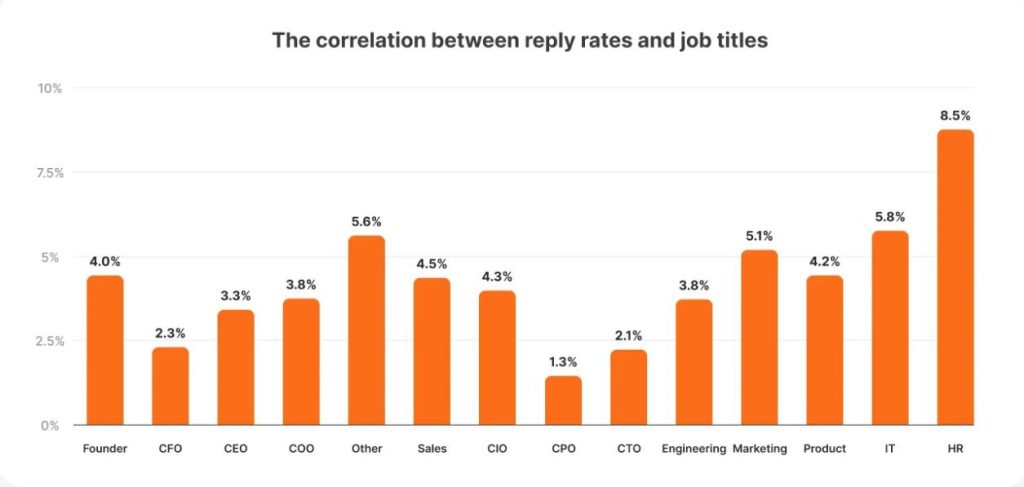
As you can see, those in HR, marketing, and IT are much more likely to reply to your emails than executives like a CFO or CTO, or those who work in engineering.
Of course, each company is different, and these response rates won’t be accurate for every organization. For example, while the VP of Business Development at one company may reply to all of your messages quickly and be engaged in the conversation, the VP of Sales at another may ghost you altogether or take days to respond.
Understanding How Decisions Are Made in Business
Here’s a closer look at a few of the different elements that go into the decisions that businesses make:
1. Defining the decision – The first element is actually recognizing that a decision needs to be made. This involves being aware of the issue at hand, why it’s a problem, and knowing what went wrong to cause it. This definition should be specific and not overly general.
For example, if your sales have tanked recently, the definition of the problem shouldn’t just be “low sales”; you should dive deeper to learn why sales have dropped. Have competitors released better products? Is your pricing too high? Are new trends making your product obsolete? There are many potential theories for you to explore.
2. Gathering information – Once they know the problem and are aware that a decision needs to occur, decision makers then begin to gather important information. This involves looking at relevant case studies, consulting with stakeholders, viewing reports, and analyzing data. The last part is especially important, as 80% of business leaders believe that data is a crucial aspect of making decisions within their company.
3. Evaluating options – Once they’ve gathered and analyzed the necessary data and information, it’s time for the decision makers to evaluate their options. This involves weighing the potential outcomes, risks, benefits, and drawbacks of the different possible solutions. Ultimately, a decision is made based on what the decision maker believes is most beneficial for the business.
Influencing Business Decisions: Key Considerations
There are several factors, both internal and external, that influence business decisions:
- The type of decision maker – Risk-takers may appreciate innovative, unique, and new approaches, whereas cautious decision makers value tried-and-true solutions. The decision maker you’re speaking with should play a role in deciding how to communicate in your pitch.
- Market conditions – Factors such as industry trends, market research, competitor behavior, customer preferences, and the overall industry landscape influence how companies make decisions.
- Economic factors – Similarly, economic factors outside of company control also influence these decisions. This can include inflation, interest rates, exchange rates, and more.
- Values and ethics – The values, beliefs, and ethics a company holds also dictate the things it chooses. For example, some companies that value the environment will pay more for an eco-friendly green solution, whereas a company that doesn’t value it as much won’t.
By understanding what factors go into any given decision, you can meet decision makers where they are.
Best Practices for Targeting Business Decision Makers
When you reach out to business decision makers, you’ll want to make your message and value proposition clear. Keep these best practices in mind to get that person on board with your proposal:
- Make it simple – Do everything you can to make the decision as easy as possible. 77% of B2B buyers said that their last purchase was extremely complex or difficult. If you can make this process effortless for them, you may have an easier time getting a response or a sale.
This could be achieved through providing clear information, offering plenty of details, providing multiple payment options, offering differentiated pricing tiers, or offering quick and personalized support.
- Use tools – With the various sales prospecting tools out there, there’s no excuse not to use them. They can offer instant access not only to contact information but also valuable intent data that tells you what decision makers are looking for, curious about, and struggling with.
- Focus on value – Within all your messages, you need to focus on value. Decision makers want to know how you can help them, and you need to be sure to highlight the value you provide at every chance. Offer practical solutions and guidance whenever possible, and position yourself as the ideal solution to their problems.
- Build a relationship – Building rapport and forming a relationship are crucial when reaching out to decision makers, and this begins by understanding their needs, not wasting their time, personalizing your approach, and listening to their concerns.
- Use a multi-channel approach – There are no rules saying you can only reach out to decision makers in one way. Don’t hesitate to reach out in multiple ways to learn the methods that your target prefers.
UpLead is the Best Tool to Find Business Decision Makers
While there are many B2B data providers out there, UpLead is the best tool to help you identify business decision makers. It has a comprehensive database of over 160 million contacts and 95% accuracy, so you can feel confident about the information you gather from the platform.
It works wonderfully as a CEO finder, verifies contact data in real time, and gives you intent data that helps you identify buyers or decision makers who are actively looking for the solution you provide.
The platform also has dozens of search filters so you can find the right people and organizations. In addition to being able to search by industry, search by location, or search by company type, UpLead also lets you search for contacts by job title.
If you’re interested in trying the UpLead contact search for yourself (or any of its other helpful features), be sure to check out the free trial.
FAQs About Decision Makers in Business
Do you want to learn more about business decision makers? If so, be sure to read these common questions, along with their answers.
Some of the top decision makers within most companies are the CEO, the COO, the CFO, and other C-suite executives.
Some examples of decision makers are the executives, directors, managers, and head buyers within an organization.
In many cases, the ultimate decision maker at a company is the CEO. However, this may vary as some companies have a board of directors that makes ultimate decisions or guides what the CEO should do.
No, while the CEO may have a major role in making decisions, several other people may make decisions, such as the marketing director, VP, COO, and even middle management in some cases.
What You Need to Remember About Business Decision Makers
Being able to properly identify decision makers is crucial for ensuring your pitch reaches someone who can approve sales or partnerships. Keep in mind that there are multiple types of decision makers, and many factors may influence the decisions they make, from company values to market conditions to various economic factors.
To reach these business decision makers and ensure your pitch has the maximum impact possible, use the tools and platforms that are available, perform proper research, know their priorities, and provide value whenever you can.

